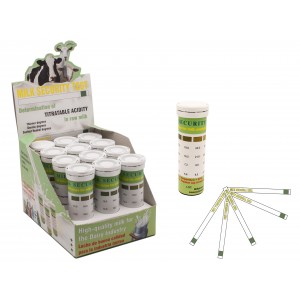Shopping Cart
0 item(s) - 0.00€
Readip - Portable Rapid Test Reader
READIP is a lightweight and portable rapid test reader and the ultimate tool for the qualitative analysis of Unisensor‘s dipstick tests. A laboratory in a small cube of only 4 cm sides. Use it on a truck or in the field. Wherever you need it! Price is 400 EUR!! ..
MILK SECURITY TEST for titratable acidity and pH
Product Code: MILK SECURITY TEST for titratable acidity and pH
Availability: 100
MILK SECURITY TEST for titratable acidity and pH
Description: The test strip has a green-blue indication area. Through it can be determined the titratable acidity of milk in three scales: 0Th (Thörner degrees) and 0D (Dornic degrees) and 0SH (Soxhlet Henkel degrees).
Principle of operation: The reaction area contains a certain amount of indicators and sodium hydroxide which in the interval of the titratable acidity from 15 to 27.5 0Th (Thörner degrees), 13.5 – 24.75 0D (Dornic degrees), and 6.0 - 11.0 0SH (Soxhlet Henkel degrees) and a pH range from 6.9 to 6.0 changes color from dark blue-green, dark green, light green to yellow-green.
Conducting the operation and reporting of results: Test strip is placed in the milk sample. Then the test strip is taken out and the excess milk is removed by tapping on the edge of the cup. Taking account of the value of titratable acidity and pH is done by comparing the obtained staining with the color scale on the label after 50 - 60 sec.
Sensitivity and selectivity: The color scale for comparing fits to the following titratable acidity: 15.0, 18.0, 24.0, 27.5 0Th (Thörner degrees); 13.5, 16.2, 21.6, 24.75 0D (Dornic degrees) and 6.0, 7.2, 9.6, 11.0 0SH (Soxhlet Henkel degrees). The color scale corresponds to the following pH values: 6.9, 6.6, 6.3 and 6.0.
Test strategy: Measurement is valid in the absence of neutralizers.
Titratable acidity: Measurement of titratable acidity (lactic acid) is a very important test used to determine the quality of raw milk. It is also defined in the production of cheese and yogurt. The titratable acidity is the percentage (%) of lactic acid in raw milk. Usually raw milk contains traces of lactic acid and has an initial natural acidity from 0.14% to 0.16%. Milk contains a large number of weak acids, weak bases and their salts, and this defines it as a buffer. There is a certain interval, in which milk has a significant acidification, but changes in the pH are not measured. Determination of acidity in this range, by titration is very important, since pH change cannot be measured with a pH test strip, or pH – meter. If this acidity is not measured, while transporting the raw milk to the factory for production of cheese and yogurt, the acidity is increasing and this proved detrimental to the quality of dairy products. Therefore, the determination of the acidity by titration of the milk is considered to be more important, and it is more real parameter in comparison with the pH.
Usually titratable acidity was determined by titration with sodium hydroxide and phenolphthalein to the establishment of the equivalent point of neutralization. Conducting titration with sodium hydroxide requires qualified
personnel, precision and appropriate laboratory. Using express dry test strips for analysis of titratable acidity of milk has significant advantages over titration - fast, easy, practical analysis, undemanding qualified personnel capable of operating at a field. The percentage of acid in milk and milk products at any time is an indicator for the storage period of the milk and the way it is processed.
pH: The measured values of titratable acidity correspond to certain values of pH. Fresh cow's milk has a pH around 6.6 – 6.8. Values greater than 6.8 indicate that the milk has coagulated and a value below 6.5 indicates the presence of colostrums or bacterial contamination. When the pH is less than 6.5, this provides an indication that significantly acidic development has occurred, due to the increased bacterial activity. Typically the pH analysis is more often used as an approval test for milk. Colostrums is more acidic when compared to normal milk, while the milk produced by cows, at the end of the lactation period and the milk produced by the ill cows, generally have higher levels of pH.

Recommendations:
- When removing a test strip from the milk sample it is necessary, to completely remove milk drops from the test paper by tapping the test strips on the edge of the cup. Then put the back side of test strips on filter paper or other paper for full removing of milk drops.
- Do not touch the indication area.
- When using the test take out only the necessary number of strips. Then the tube must be tightly closed (hear a click)
Storage: Express test strips should be stored in tightly closed tube in a dry and dark place, never in the refrigerator.
1 box consists of 12 tubes / 600 strip tests ( test for titratable )
Write a review
Your Name:Your Review: Note: HTML is not translated!
Rating: Bad Good
Enter the code in the box below:




-160x160.jpg)




















 (
(